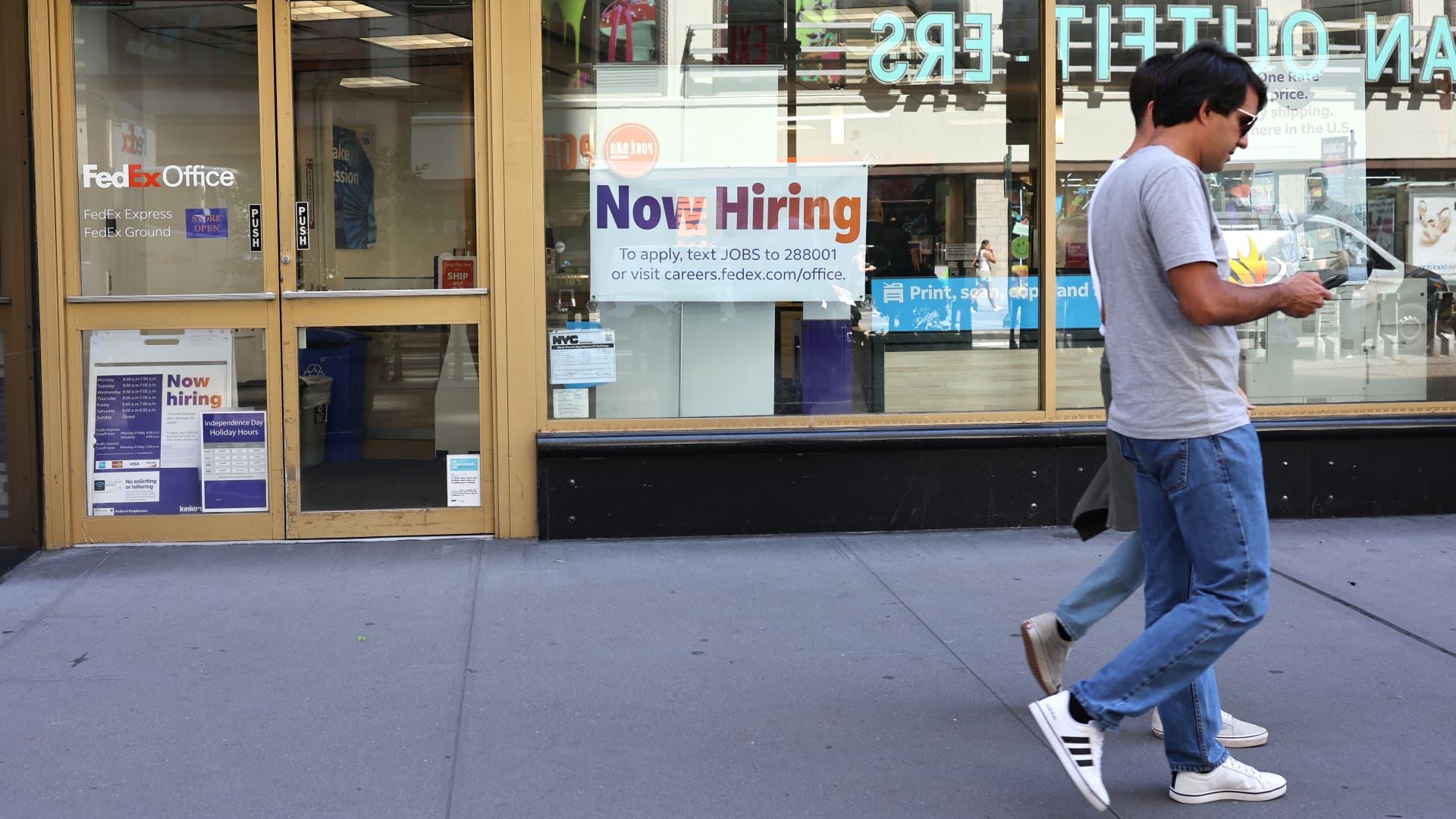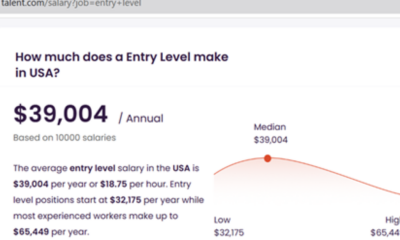A “Now Hiring” sign is seen at a FedEx location on Broadway on June 07, 2024 in New York City.
Michael M. Santiago | Getty Images
The U.S. job market is cooling at a worrisome rate but not to an extent that warrants panic — at least, not yet, according to economists.
Their concern lies with the momentum of key labor-market metrics like unemployment, job growth and hiring.
Such barometers, which were historically strong just a year or so ago, have gradually weakened as the Federal Reserve raised interest rates to cool the economy and bring down inflation.
More from Personal Finance:
Unemployment system unprepared for a recession
Working 10-to-4 is the new 9-to-5
Recession could upend retirement plans
A recession could result if the labor market keeps throttling back at its current pace, economists said.
“We’re still on this trajectory that’s not a three-alarm fire right now,” said Nick Bunker, economic research director for North America at the job site Indeed.
But if the decline doesn’t level off soon, he said, a soft landing for the economy may not be in the offing: “We’re going to land but it’s going to land with a crash.”
Why there’s ‘slowing momentum’
Employers added 142,000 jobs in August, the Bureau of Labor Statistics reported Friday, a figure that was lower than expected.
The good news: That figure is an increase from the 89,000 jobs added in July. The unemployment rate also fell slightly, to 4.2% from 4.3% in July.
However, several metrics point to “slowing momentum” throughout the labor market, said Ernie Tedeschi, director of economics at the Yale Budget Lab and former chief economist of the White House Council of Economic Advisers under the Biden administration.
The current level of job growth and unemployment “would be fine for the U.S. economy sustained over many months,” he said. “Problem is, other data don’t give us confidence we are going to stay there.”
For example, average job growth was 116,000 over the past three months; the three-month average was 211,000 a year ago. The unemployment rate has also steadily risen, from 3.4% as recently as April 2023.
Employers are also hiring at their slowest pace since 2014, according to separate Labor Department data issued earlier this week.
Hiring hasn’t been broad based, either: Private-sector job growth outside of the healthcare and social-assistance fields has been “unusually slow,” at a roughly 39,000 average over the past three months versus 79,000 over the past year and 137,000 over 2015 to 2019, according to Julia Pollak, chief economist at ZipRecruiter.
Workers are also quitting their jobs at the lowest rate since 2018, while job openings are at their lowest since January 2021. Quits are a barometer of workers’ confidence in their ability to find a new job.
Job-finding among unemployed workers is around 2017 levels and “continues to drift down,” Bunker said.
“There’s a very consistent picture that the strong labor-market momentum we saw in 2022 and 2023 has slowed considerably,” Tedeschi said.
Overall, data points “are not necessarily concerning or at recessionary levels yet,” he added. “[But] they are softer. They may be preludes to a recession.”
Why layoff data is a silver lining
However, there is some room for optimism, economists said.
Permanent layoffs — which have historically been “the soothsayer of recessions” — haven’t really budged, Tedeschi said.
Federal data for unemployment insurance claims and the rate of layoffs suggest employers are holding on to their workers, for example.
The recent gradual rise in unemployment is largely not attributable to layoffs, economists said. It has been for a “good” reason: a large increase in labor supply. In other words, many more Americans entered the job market and looked for work; they’re counted as unemployed until they find a job.
“Once we start seeing layoffs, the game is over and we are in a recession,” Tedeschi said. “And that has not happened at all.”
That said, the job hunt has become more challenging for job seekers than in the recent past, according to Bunker.
Relief from the Fed won’t come quickly
Federal Reserve officials are expected to start cutting interest rates at their upcoming meeting this month, which would take pressure off the economy.
Lower borrowing costs may spur consumers to buy homes and cars, and for businesses to make more investments and hire more workers accordingly, for example.
That relief likely wouldn’t be instantaneous but would probably take many months to wind through the economy, economists said.
Overall, though, the current picture is “still consistent with an economy experiencing a soft landing rather than plummeting into recession,” Paul Ashworth, chief North America economist at Capital Economics, wrote in a note Friday.


 Accounting7 days ago
Accounting7 days ago
 Accounting1 week ago
Accounting1 week ago
 Accounting1 week ago
Accounting1 week ago
 Economics7 days ago
Economics7 days ago
 Economics5 days ago
Economics5 days ago
 Personal Finance1 week ago
Personal Finance1 week ago
 Personal Finance1 week ago
Personal Finance1 week ago
 Economics7 days ago
Economics7 days ago












